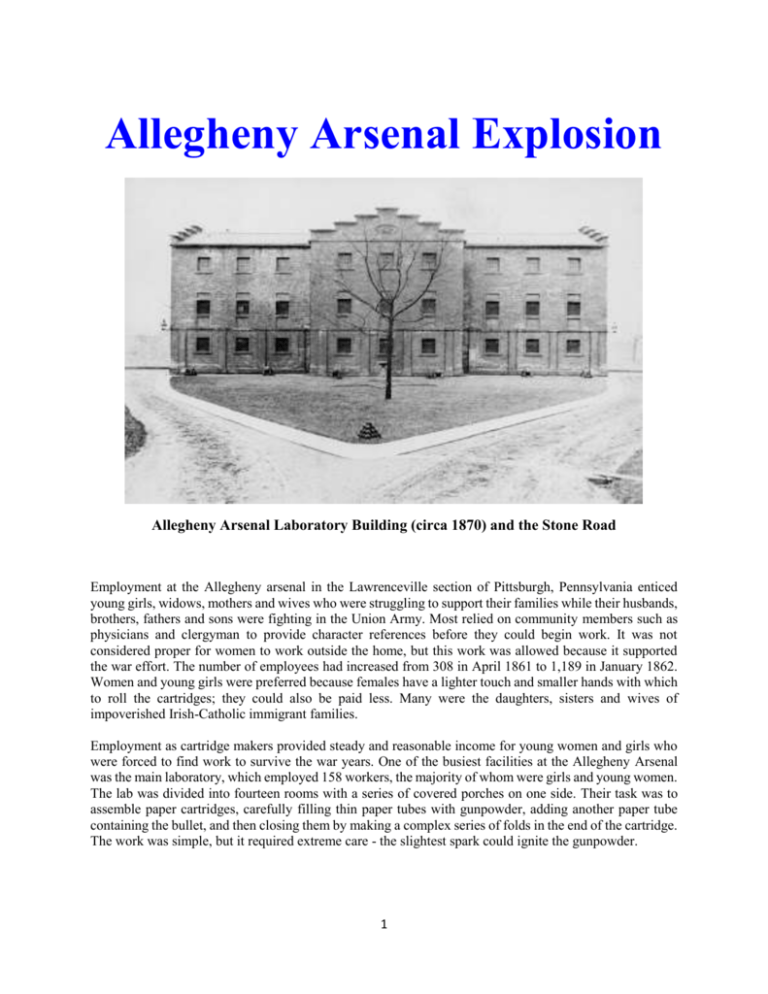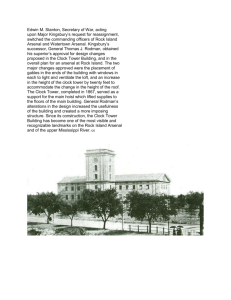Mil-Hist-CW-Alleghany-Arsenal-Explosion
advertisement

Allegheny Arsenal Explosion Allegheny Arsenal Laboratory Building (circa 1870) and the Stone Road Employment at the Allegheny arsenal in the Lawrenceville section of Pittsburgh, Pennsylvania enticed young girls, widows, mothers and wives who were struggling to support their families while their husbands, brothers, fathers and sons were fighting in the Union Army. Most relied on community members such as physicians and clergyman to provide character references before they could begin work. It was not considered proper for women to work outside the home, but this work was allowed because it supported the war effort. The number of employees had increased from 308 in April 1861 to 1,189 in January 1862. Women and young girls were preferred because females have a lighter touch and smaller hands with which to roll the cartridges; they could also be paid less. Many were the daughters, sisters and wives of impoverished Irish-Catholic immigrant families. Employment as cartridge makers provided steady and reasonable income for young women and girls who were forced to find work to survive the war years. One of the busiest facilities at the Allegheny Arsenal was the main laboratory, which employed 158 workers, the majority of whom were girls and young women. The lab was divided into fourteen rooms with a series of covered porches on one side. Their task was to assemble paper cartridges, carefully filling thin paper tubes with gunpowder, adding another paper tube containing the bullet, and then closing them by making a complex series of folds in the end of the cartridge. The work was simple, but it required extreme care - the slightest spark could ignite the gunpowder. 1 Winslow Homer engraving of women and girls rolling cartridges at a federal arsenal in Massachusetts, published July 1861, Harper's Weekly In battle, soldiers had to load their rifles after each shot. This involved tearing open the cartridge - usually with their teeth - and pouring the powder, then the bullet, down the barrel of the gun. The soldier then tamped down all this with a ramrod, cocked the rifle and fired. It was an incredibly slow process, and soldiers stood exposed to enemy fire while they performed all these tasks. On September 17, 1862, the bloodiest day of the Civil War, the Battle of Antietam was raging at near Sharpsburg, Maryland, 156 women were working at the Arsenal to make much needed ammunition for Union troops. Most of these young women, some as young as 14, worked six days a week, twelve hours a day, and turned out 128,000 cartridges daily, for which they earned 50 cents to $1.10 per day. Each worker was expected to produce a daily minimum, based on one's individual abilities and past performance. Those unable to meet their quota were subject to dismissal. In a cruel irony, girls had only recently replaced boys on the munitions work force at the Arsenal. Some boys were tobacco smokers and had been dismissed because they were careless with matches. Sparks on the Stone Road When Colonel John Symington was appointed Commander of the Arsenal, he had a macadamized road built between the laboratory and other buildings. This type of road contained pieces of hard, flinty stone, and the workers warned management about the potential for an explosion if any of the powder came in contact with the new road. Alexander McBride – Superintendent of the Laboratory – had wood chips and sawdust spread over the stone road to help prevent sparks, but Symington insisted that it all be swept away. When asked to give the employees a half-holiday on a Saturday so they could get rid of the powder that had accumulated over time, Symington refused. McBride also complained that E.I. DuPont insisted on recycling its wooden powder barrels, which led to loose-fitting lids and spilled powder. The Explosions Around 2pm, on the 17th Joseph Frick was delivering wooden barrels of DuPont black powder in a horsedrawn wagon up the new stone road. Rachel Dunlap, an employee in the lab watched as Frick maneuvered his wagon into position to offload the barrels. Just then she saw a spark flash near the horse's hooves (with iron horseshoes) and the iron-clad wagon wheels. Then she saw a sheet of flame. All it took was one tiny spark. 2 At the sound of the first explosion, Colonel Symington rushed to the laboratory. About 300 girls and boys working in the storehouse on the floor below the main lab were in a panic, and many rushed to the stairs, creating a bottleneck on the landing. Some jumped out of second-story windows in an effort to escape, breaking limbs in the process. Lieutenant John Edie rushed to the storehouse, and tried to calm the workers until ladders could be brought. Just as the situation in the storehouse was under control, a second explosion set the laboratory building on fire. Panic-stricken workers ran from buildings as the air filled with clouds of smoke and the acrid odors of sulfur and burning flesh. Others tried to flee, but became trapped when flaming walls and roofs collapsed on top of them. Firefighting equipment was brought to the scene, as well as a bucket brigade who tried to douse the flames with water. The volunteer fire company from Pittsburgh arrived in horse-drawn wagons and assisted in bringing the fire under control. By the time the fire was put out, the lab had been reduced to a pile of smoldering rubble. Death of the Innocent Many of the victims died in horrific ways. Witnesses reported bodies bursting in midair. A body does not survive 125,000 rounds of exploding ammunition, not to mention a couple hundred parrot-gun projectiles. Where the heat was most intense, there was nothing left but white bones in a heap. A stray arm flew beyond the Arsenal's massive stone wall. A shoeless foot was found near the main gate. The ground was littered with body parts and smoldering shards of wood. The Gazette reported a brass tube impaled through the heart of one victim. People poured out onto Penn Avenue - ministers, neighbors, friends and relatives of the workers - running toward the disaster. There were bitter tears of anguish from those who recognized the deceased or sought in vain for those who could never return. Almost three-quarters of the dead girls were so badly burned or disfigured, that they could not be identified. Just as Antietam would prove the costliest day in military dead, the Arsenal explosion would produce the largest civilian death tally in the Civil War. The 34-acre complex became a grim public morgue with bodies laid out on wooden planks. Eyewitness Accounts Arsenal worker Mary Jane Black remembered the pandemonium: 3 Two girls behind me; they were on fire; their faces were burning and blood running from them. I pulled the clothes off one of them; while I was doing this, the other one ran up and begged me to cover her. I did not succeed in saving either one. Contemporary newspaper accounts spared no details about what horrors greeted people rushing to the scene. This graphic description appeared in the Daily Post: Of the main building nothing remained but a heap of smoking debris. The ground about was strewn with fragments of charred wood, torn clothing, balls, caps, grape shot, exploded shells, hoes, fragments of dinner baskets belonging to the inmates, steel springs from the girls' hoop skirts, cartridge paper, sheet iron and melted lead. Two hundred feet from the laboratory was picked up the body of one young girl, terrible mangled; another body was seen to fly in the air and separate into two parts. An arm was thrown over the wall; a foot was picked up near the gate; a piece of skull was found a hundred yards away, and pieces of intestines were scattered about the grounds. Some fled out of the ruins covered with flame, or blackened and lacerated with effects of the explosion, and either fell and expired or lingered in agony until removed. Several were conveyed to houses in the borough and to their homes in the city. Of these, four or five subsequently died. A reporter for The Pittsburgh Evening Chronicle described the sights and sounds: ...agonizing screams of relatives and friends upon discovering the remains of some loved one whose humble earnings contributed to their comfort... There was not a particle of clothing left on a majority of the victims, and mangled and disjointed as they were it was impossible to identify them. The very stockings were torn from their feet, rings from their fingers, and in some instances nothing but a headless trunk remained. Nevertheless, many were identified by their hair, by a scrap of the dress they wore, but the greatest number never can be fully recognized. Almost 150 workers were injured in the explosions, many with agonizing burns. Others in distant buildings were injured in the ensuing panic, trying to escape through crowded wooden stairwells. Another, in the attempt to avoid the stairwells' bottleneck, broke her neck jumping from a window. Allegheny Cemetery donated a parcel of land, and the federal government issued thirty-nine black coffins for the unidentified remains. (Some sources say forty-five were buried here.) On September 18, 1862, the day after the explosions, the mayors of Pittsburgh and Lawrenceville, along with clergy and council members, watched as each coffin was lowered into the mass grave. Allegheny Arsenal Monument 4 In 1863 an Egyptian obelisk inscribed with the names of the victims was raised over the common grave of the unidentified arsenal workers in Allegheny Cemetery. The next sixty-five years took their toll on the monument, and in 1928 it was replaced with a newer memorial which is inscribed with the names of the victims. Allegheny Arsenal Monument The explosion at the Allegheny Arsenal on September 17, 1862 was the worst civilian disaster associated with the Civil War. This monument was erected in 1928 to honor the memory of thirty-nine young women buried here, half of the 78 young workers killed in the accident at the arsenal. The Elusive Cause The cause of the Arsenal explosion has never been fully determined. A coroner's inquest began immediately that evening, and eventually determined that a spark from the combustion of either an iron horseshoe or iron-rimmed wagon wheel was ignited when the metal contacted black powder that had been swept onto the macadamized road in front of the laboratory building. The spark then traveled to the porch and into the building, setting off powder as it went. A coroner's jury stated that the accident had been the result of the negligent conduct of Colonel John Symington and his subordinates in allowing loose powder to accumulate on the roadway and elsewhere. However, during a subsequent military inquiry into the conduct of Symington, many of the same witnesses who had appeared before the coroner changed their testimony. In the end, Symington was found innocent of any wrongdoing by the Union Army, and the court concluded that "the cause of the explosion could not be satisfactorily ascertained..." Symington, in a letter to the Ordnance Department two days after the explosion, speculated that it had been caused "by the leaking out of powder when one of the barrels was being placed on the platform." Others have pointed to lax enforcement of safety rules by Alexander McBride, the civilian superintendent of the lab. Many have argued that the leaky wooden barrels with loose lids used by DuPont to ship gunpowder to the arsenal also played a role, and that because DuPont was the main supplier of powder, the company's culpability in the accident might never have been fully investigated. The ultimate cause of the explosion was never determined, but many witnesses reported seeing barrels leaking powder as they were moved around the complex. In fact the problem of leaking barrels seemed to be the one point of agreement among all witnesses. Alexander McBride had repeatedly complained that the powder shipped by DuPont was delivered in defective barrels with loose covers. But in the end, the final word still belongs to the Army inquiry and their ruling is that the exact cause remains unknown. The Guilty Three men were charged with being grossly negligent in the explosion: Arsenal Commander John Symington, his subordinate, Lt. John Edie, and Alexander McBride, whose sworn testimony was heartbreaking. After escaping from his office through a window, McBride's first thought was to rescue his 14-year-old daughter Kate, but he could only watch as the flaming ceiling fell on the room where she worked. 5 After rushing to a powder magazine nearby and closing its door to prevent more explosions, McBride spent the rest of the day helping the wounded. He recounted how he ran around throwing buckets of water on screaming people. He came across Annie Shook and Anna Sibley, burned and naked, crying as they tried to dig their way under a wooden fence. They pleaded for help. Pleaded for clothing. The Aftermath Alexander McBride lived a life of relative seclusion after the explosion. But, in the late 1890s he met with 300 former employees to sign a petition demanding that Congress award $30,000 to be split among victims and families. Nearly 40 years had passed without any compensation. Congress denied the petition, saying the money was needed to finance the Spanish-American War. Officials hastily arranged to put the tragedy behind them. The cartridge making operation could not be halted for very long because the Union Army badly needed ammunition. Temporary buildings were erected to house the employees, and a new laboratory was built the following year. Throughout the war the arsenal continued to supply the Federal army with arms and ammunition. After the war, the Allegheny Arsenal served primarily as a storage facility for the Ordnance Department and Quartermaster Corps. In the 1920s, the government relinquished control of the arsenal property to the city, and most of the land was sold off. Today the site of the explosion is in a ballfield in Arsenal Park. The deaths at Lawrenceville were just as real as those at Antietam, Fredericksburg and Gettysburg, and the sacrifices here were just as great. No one can say what these girls might have accomplished had they lived. These words appeared on the original grave marker, and is also on the 1928 monument: Tread softly, this is consecrated dust, forty-five pure patriotic victims lie here. A sacrifice to freedom and civil liberty, a horrid memento of a most wicked rebellion. Patriots! these are patriots' graves, friends of humble, honest toil, these were your peers. Fervent affection kindled these hearts, honest industry employed these hands, widows' and orphans' tears have watered the ground. Female beauty and manhood's vigor commingle here. Identified by man, known by Him who is the resurrection and the life, to be made known and loved again when the morning cometh. Allegany Arsenal Powder Magazine, built 1814, perhaps the only original portion of the former Arsenal still intact and the Arsenal’s front gate (circa 1937) [Source: Civil War Women | Maggie MacLean | Apr 04, 2014 ++] 6







